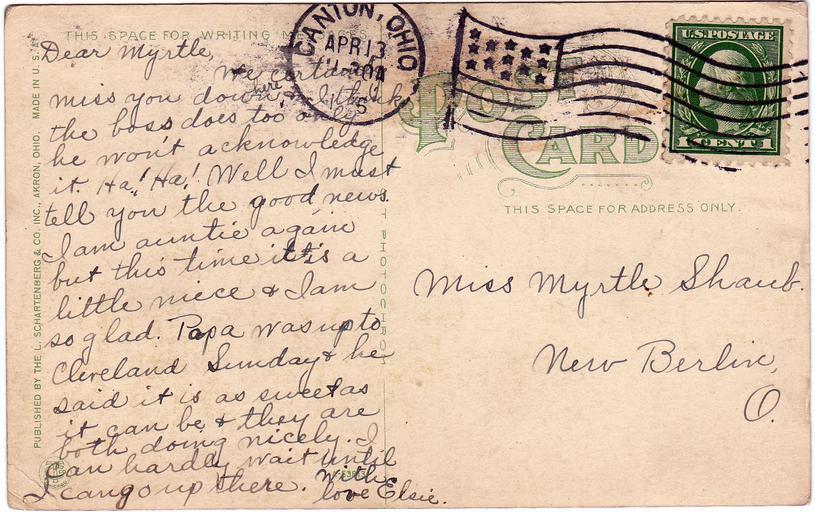MAKE A MEME
View Large Image

| View Original: | Back_of_Dueber-Hampden_Watch_Works,_Canton,_Ohio._(1915).jpg (1274x800) | |||
| Download: | Original | Medium | Small | Thumb |
| Courtesy of: | www.flickr.com | More Like This | ||
| Keywords: postcard ohio canton, ohio cantonohio stamp postmarked used dueber-hampden watch works dueberhampdenwatchworks l. schartenberg & co., inc. lschartenbergcoinc curt teich co. curtteichco divided back era dividedbackera 1915 divided back dividedback shaub myrtle shaub myrtleshaub 1910s flag cancel flagcancel canton cancel text writing document Description on card: Dueber-Hampden Watch Works, Canton, Ohio. Publisher: L. Shartenberg & Co., Inc., Akron, Ohio | C.T. Photochrome by Curt Teich Co., Chicago, Illinois Postmark on back of card: Apr 13, 1915(?) 11:30 a.m. Message: Dear Myrtle, We certainly miss you down here. I think the boss does too only he won't acknowledge it. Ha! Ha! Well I must tell you the good news. I am auntie again but this time it'a a little niece & I am so glad. Papa was up to Cleveland Sunday & he said it was as sweet as it can be & they are both doing nicely. I can hardly wait until I can go up there. With love, Elsie Addressed to: Miss Myrtle Shaub New Berlin, O. Used. Publisher Note: Curt Teich emigrated to Chicago in 1895. He had worked as a lithographer in Lobenstein, Germany. He founded the Curt Teich Company in 1898, concentrating on newspaper and magazine printing. He was an early publisher of postcards, but he didn't begin printing them himself until 1908. According to MetroPostcard.com, "As his competition dwindled, his sales expanded and his American factories would eventually turn out more postcards than any other in the United States. " The company was best known for their wide range of advertising and postcards of North America. By the 1920s, it was producing so many postcards with borders that they became recognized as a type dubbed "White Border Cards," creating an "era." Curt Teich started using offset presses in 1907, but it took a number of years before he had offset presses made to his satisfaction, and many more years for him to perfect the method. His innovations in this printing technique directly led to the production of what we now call "linens" by the early 1930s. The company aided the war effort during the second world war by also printing many military maps. Curt Teich eventually turned management of the company over to his son, but he remained active in company operations throughout its history. Curt Teich died in 1974 and the family business was sold to Regensteiner Publishers who continued to print postcards at the Chicago plant until 1978 when the rights to the company name and processes were sold to the Irish company, John Hinde Ltd. Their California subsidiary now prints postcards under the name John Hinde Curteich, Inc. Source: www.metropostcard.com/publisherst.html Description on card: Dueber-Hampden Watch Works, Canton, Ohio. Publisher: L. Shartenberg & Co., Inc., Akron, Ohio | C.T. Photochrome by Curt Teich Co., Chicago, Illinois Postmark on back of card: Apr 13, 1915(?) 11:30 a.m. Message: Dear Myrtle, We certainly miss you down here. I think the boss does too only he won't acknowledge it. Ha! Ha! Well I must tell you the good news. I am auntie again but this time it'a a little niece & I am so glad. Papa was up to Cleveland Sunday & he said it was as sweet as it can be & they are both doing nicely. I can hardly wait until I can go up there. With love, Elsie Addressed to: Miss Myrtle Shaub New Berlin, O. Used. Publisher Note: Curt Teich emigrated to Chicago in 1895. He had worked as a lithographer in Lobenstein, Germany. He founded the Curt Teich Company in 1898, concentrating on newspaper and magazine printing. He was an early publisher of postcards, but he didn't begin printing them himself until 1908. According to MetroPostcard.com, "As his competition dwindled, his sales expanded and his American factories would eventually turn out more postcards than any other in the United States. " The company was best known for their wide range of advertising and postcards of North America. By the 1920s, it was producing so many postcards with borders that they became recognized as a type dubbed "White Border Cards," creating an "era." Curt Teich started using offset presses in 1907, but it took a number of years before he had offset presses made to his satisfaction, and many more years for him to perfect the method. His innovations in this printing technique directly led to the production of what we now call "linens" by the early 1930s. The company aided the war effort during the second world war by also printing many military maps. Curt Teich eventually turned management of the company over to his son, but he remained active in company operations throughout its history. Curt Teich died in 1974 and the family business was sold to Regensteiner Publishers who continued to print postcards at the Chicago plant until 1978 when the rights to the company name and processes were sold to the Irish company, John Hinde Ltd. Their California subsidiary now prints postcards under the name John Hinde Curteich, Inc. Source: www.metropostcard.com/publisherst.html | ||||